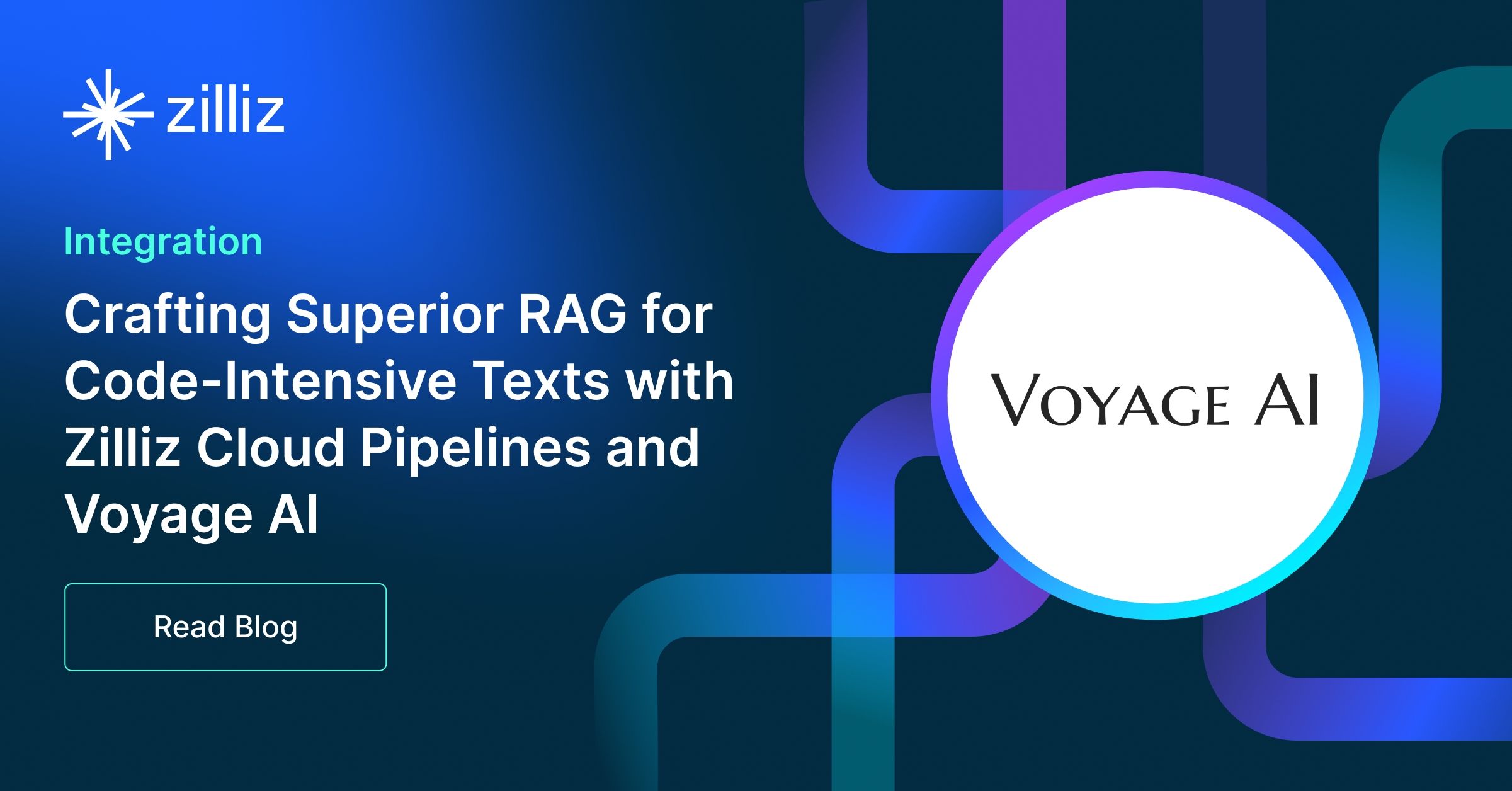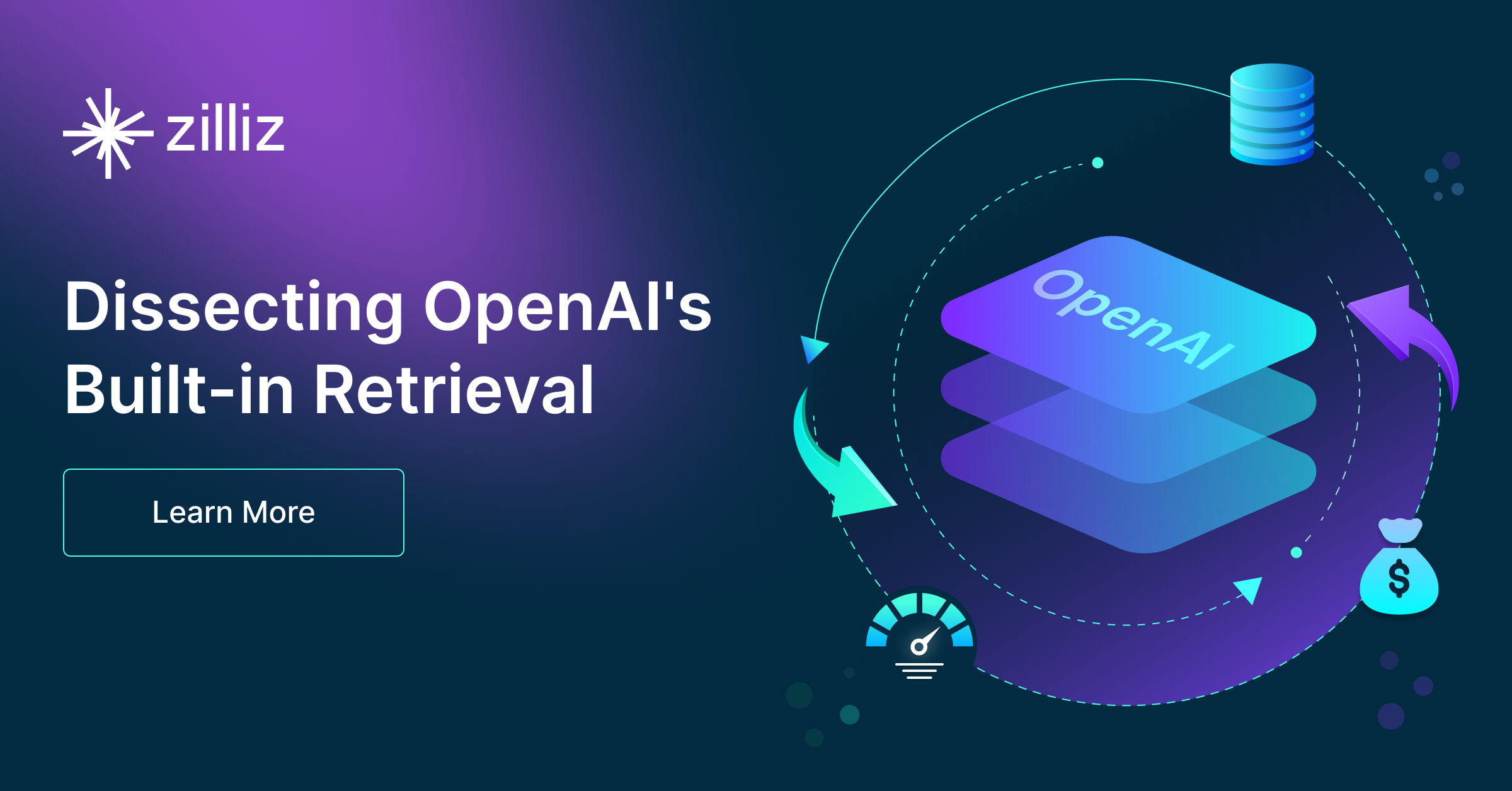Build RAG Chatbot with LangChain, LangChain vector store, OpenAI GPT-o1, and Ollama paraphrase-multilingual
Introduction to RAG
Retrieval-Augmented Generation (RAG) is a game-changer for GenAI applications, especially in conversational AI. It combines the power of pre-trained large language models (LLMs) like OpenAI’s GPT with external knowledge sources stored in vector databases such as Milvus and Zilliz Cloud, allowing for more accurate, contextually relevant, and up-to-date response generation. A RAG pipeline usually consists of four basic components: a vector database, an embedding model, an LLM, and a framework.
Key Components We'll Use for This RAG Chatbot
This tutorial shows you how to build a simple RAG chatbot in Python using the following components:
- LangChain: An open-source framework that helps you orchestrate the interaction between LLMs, vector stores, embedding models, etc, making it easier to integrate a RAG pipeline.
- LangChain in-memory vector store: an in-memory, ephemeral vector store that stores embeddings in-memory and does an exact, linear search for the most similar embeddings. The default similarity metric is cosine similarity, but can be changed to any of the similarity metrics supported by ml-distance. It is intended for demos and does not yet support ids or deletion. (If you want a much more scalable solution for your apps or even enterprise projects, we recommend using Zilliz Cloud, which is a fully managed vector database service built on the open-source Milvusand offers a free tier supporting up to 1 million vectors.)
- OpenAI GPT-01: This foundational model marks the beginning of OpenAI’s generative pre-trained transformers. With its broad training on diverse text, GPT-01 is proficient in various NLP tasks including text generation, translation, and conversation. Its versatility makes it ideal for prototyping applications and enhancing interactive user experiences in early AI deployments.
- Ollama Paraphrase-Multilingual: This AI model specializes in generating paraphrases across multiple languages, enhancing content diversity and accessibility. Its strength lies in understanding context while altering sentence structure, making it ideal for translation services, content creation, and multilingual learning applications.
By the end of this tutorial, you’ll have a functional chatbot capable of answering questions based on a custom knowledge base.
Note: Since we may use proprietary models in our tutorials, make sure you have the required API key beforehand.
Step 1: Install and Set Up LangChain
%pip install --quiet --upgrade langchain-text-splitters langchain-community langgraph
Step 2: Install and Set Up OpenAI GPT-o1
pip install -qU "langchain[openai]"
import getpass
import os
if not os.environ.get("OPENAI_API_KEY"):
os.environ["OPENAI_API_KEY"] = getpass.getpass("Enter API key for OpenAI: ")
from langchain.chat_models import init_chat_model
llm = init_chat_model("o1", model_provider="openai")
Step 3: Install and Set Up Ollama paraphrase-multilingual
pip install -qU langchain-ollama
from langchain_ollama import OllamaEmbeddings
embeddings = OllamaEmbeddings(model="paraphrase-multilingual")
Step 4: Install and Set Up LangChain vector store
pip install -qU langchain-core
from langchain_core.vectorstores import InMemoryVectorStore
vector_store = InMemoryVectorStore(embeddings)
Step 5: Build a RAG Chatbot
Now that you’ve set up all components, let’s start to build a simple chatbot. We’ll use the Milvus introduction doc as a private knowledge base. You can replace it with your own dataset to customize your RAG chatbot.
import bs4
from langchain import hub
from langchain_community.document_loaders import WebBaseLoader
from langchain_core.documents import Document
from langchain_text_splitters import RecursiveCharacterTextSplitter
from langgraph.graph import START, StateGraph
from typing_extensions import List, TypedDict
# Load and chunk contents of the blog
loader = WebBaseLoader(
web_paths=("https://milvus.io/docs/overview.md",),
bs_kwargs=dict(
parse_only=bs4.SoupStrainer(
class_=("doc-style doc-post-content")
)
),
)
docs = loader.load()
text_splitter = RecursiveCharacterTextSplitter(chunk_size=1000, chunk_overlap=200)
all_splits = text_splitter.split_documents(docs)
# Index chunks
_ = vector_store.add_documents(documents=all_splits)
# Define prompt for question-answering
prompt = hub.pull("rlm/rag-prompt")
# Define state for application
class State(TypedDict):
question: str
context: List[Document]
answer: str
# Define application steps
def retrieve(state: State):
retrieved_docs = vector_store.similarity_search(state["question"])
return {"context": retrieved_docs}
def generate(state: State):
docs_content = "\n\n".join(doc.page_content for doc in state["context"])
messages = prompt.invoke({"question": state["question"], "context": docs_content})
response = llm.invoke(messages)
return {"answer": response.content}
# Compile application and test
graph_builder = StateGraph(State).add_sequence([retrieve, generate])
graph_builder.add_edge(START, "retrieve")
graph = graph_builder.compile()
Test the Chatbot
Yeah! You've built your own chatbot. Let's ask the chatbot a question.
response = graph.invoke({"question": "What data types does Milvus support?"})
print(response["answer"])
Example Output
Milvus supports various data types including sparse vectors, binary vectors, JSON, and arrays. Additionally, it handles common numerical and character types, making it versatile for different data modeling needs. This allows users to manage unstructured or multi-modal data efficiently.
Optimization Tips
As you build your RAG system, optimization is key to ensuring peak performance and efficiency. While setting up the components is an essential first step, fine-tuning each one will help you create a solution that works even better and scales seamlessly. In this section, we’ll share some practical tips for optimizing all these components, giving you the edge to build smarter, faster, and more responsive RAG applications.
LangChain optimization tips
To optimize LangChain, focus on minimizing redundant operations in your workflow by structuring your chains and agents efficiently. Use caching to avoid repeated computations, speeding up your system, and experiment with modular design to ensure that components like models or databases can be easily swapped out. This will provide both flexibility and efficiency, allowing you to quickly scale your system without unnecessary delays or complications.
LangChain in-memory vector store optimization tips
LangChain in-memory vector store is just an ephemeral vector store that stores embeddings in-memory and does an exact, linear search for the most similar embeddings. It has very limited features and is only intended for demos. If you plan to build a functional or even production-level solution, we recommend using Zilliz Cloud, which is a fully managed vector database service built on the open-source Milvus and offers a free tier supporting up to 1 million vectors.)
OpenAI GPT-o1 optimization tips
GPT-o1 is designed for optimized efficiency and cost-effectiveness, making it well-suited for scalable RAG systems. Improve retrieval performance by implementing dynamic retrieval depth—fetching broader context for complex queries and narrower focus for straightforward ones. Use prompt compression techniques to remove unnecessary metadata while maintaining core information. Adjust temperature settings (0.1–0.3) based on the required response specificity, ensuring balanced output quality. Deploy caching strategies for repeated queries to enhance response speed and lower operational costs. Utilize function calling to structure responses and avoid ambiguous or overly verbose answers. When handling large-scale workloads, distribute requests across multiple instances to balance resource allocation and reduce bottlenecks. Monitor API usage and optimize retrieval strategies continuously to maintain efficiency.
Ollama Paraphrase-Multilingual Optimization Tips
To optimize the Ollama paraphrase-multilingual component in your Retrieval-Augmented Generation (RAG) setup, ensure that your training dataset is diverse and representative of the languages and dialects you intend to support, as this enhances paraphrasing accuracy across contexts. Use transfer learning with domain-specific data to improve performance on niche topics. Adjust hyperparameters such as learning rate and batch size based on validation results to enhance convergence. Implement a caching mechanism for frequently accessed paraphrases to reduce response time during retrieval. Monitor and analyze performance metrics regularly to identify bottlenecks, and consider fine-tuning the model periodically based on user feedback and new datasets to adapt to evolving language use.
By implementing these tips across your components, you'll be able to enhance the performance and functionality of your RAG system, ensuring it’s optimized for both speed and accuracy. Keep testing, iterating, and refining your setup to stay ahead in the ever-evolving world of AI development.
RAG Cost Calculator: A Free Tool to Calculate Your Cost in Seconds
Estimating the cost of a Retrieval-Augmented Generation (RAG) pipeline involves analyzing expenses across vector storage, compute resources, and API usage. Key cost drivers include vector database queries, embedding generation, and LLM inference.
RAG Cost Calculator is a free tool that quickly estimates the cost of building a RAG pipeline, including chunking, embedding, vector storage/search, and LLM generation. It also helps you identify cost-saving opportunities and achieve up to 10x cost reduction on vector databases with the serverless option.
 Calculate your RAG cost
Calculate your RAG cost
What Have You Learned?
By diving into this tutorial, you’ve learned how to weave together cutting-edge tools to create a powerful Retrieval-Augmented Generation (RAG) system! You started by leveraging LangChain as the backbone framework, orchestrating the flow of data and logic between components seamlessly. With LangChain’s vector store, you discovered how to efficiently store and retrieve context-rich embeddings, transforming unstructured data into a searchable knowledge base. Then came the magic of OpenAI’s GPT-4 (or alternatives like Ollama’s lightweight models), which breathed life into the system, generating human-like responses grounded in the retrieved context. You also explored how embedding models like Ollama’s paraphrase-multilingual empower your RAG pipeline to handle multilingual queries, breaking language barriers and expanding your application’s reach. Along the way, you picked up optimization tricks—like chunking strategies and model fine-tuning—to balance speed, cost, and accuracy. And let’s not forget the free RAG cost calculator you now have in your toolkit, helping you make informed decisions without guesswork!
What’s next? You’re equipped to build intelligent applications that learn from data, understand context, and deliver precise answers. Whether you’re enhancing customer support bots, creating research assistants, or crafting multilingual tools, the foundation is yours to expand. Experiment with different vector databases, swap LLMs for niche use cases, or tweak embeddings for domain-specific accuracy. The possibilities are limitless, and every iteration brings you closer to mastering AI’s potential. So fire up your IDE, play with the code, and let your creativity run wild—you’ve got everything you need to turn ideas into impactful solutions. The future of AI is collaborative, iterative, and yours to shape. Let’s build it! 🚀
Further Resources
🌟 In addition to this RAG tutorial, unleash your full potential with these incredible resources to level up your RAG skills.
- How to Build a Multimodal RAG | Documentation
- How to Enhance the Performance of Your RAG Pipeline
- Graph RAG with Milvus | Documentation
- How to Evaluate RAG Applications - Zilliz Learn
- Generative AI Resource Hub | Zilliz
We'd Love to Hear What You Think!
We’d love to hear your thoughts! 🌟 Leave your questions or comments below or join our vibrant Milvus Discord community to share your experiences, ask questions, or connect with thousands of AI enthusiasts. Your journey matters to us!
If you like this tutorial, show your support by giving our Milvus GitHub repo a star ⭐—it means the world to us and inspires us to keep creating! 💖
- Introduction to RAG
- Key Components We'll Use for This RAG Chatbot
- Step 1: Install and Set Up LangChain
- Step 2: Install and Set Up OpenAI GPT-o1
- Step 3: Install and Set Up Ollama paraphrase-multilingual
- Step 4: Install and Set Up LangChain vector store
- Step 5: Build a RAG Chatbot
- Optimization Tips
- RAG Cost Calculator: A Free Tool to Calculate Your Cost in Seconds
- What Have You Learned?
- Further Resources
- We'd Love to Hear What You Think!
Content
Vector Database at Scale
Zilliz Cloud is a fully-managed vector database built for scale, perfect for your RAG apps.
Try Zilliz Cloud for Free


